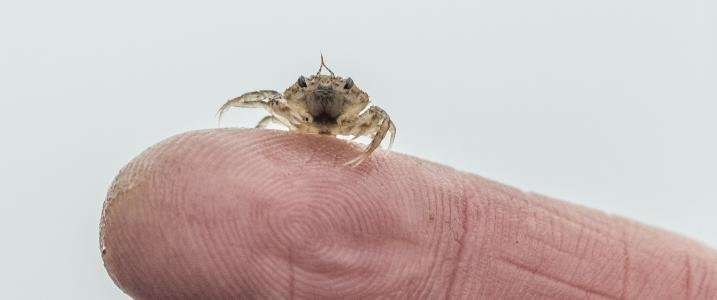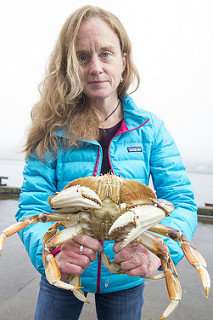Little genetic difference among Dungeness crab from California to Washington

A new study of Dungeness crab along the West Coast found strong genetic diversity throughout various sampling sites, with little genetic "differentiation" between them, meaning that crab found off the California coast are similar to those found off Oregon and Washington.
The researchers say the lack of significant differentiation means there likely are not multiple genetic sub-populations of Dungeness crab along the coast, which could have necessitated new management strategies.
The study, which was supported by an Oregon Sea Grant award to Kathleen O'Malley of Oregon State University, has been published in the journal Molecular Ecology.
"The lack of strong differentiation suggests that our Dungeness crab along the West Coast are part of a 'single evolutionary population,'" said lead author Tyler Jackson, who led the study as a master's degree student in the Department of Fisheries and Wildlife at Oregon State. "There is enough genetic exchange throughout the California Current System to prevent the population from diverging into multiple sub-populations."
"But at a local scale, crabs found in Washington likely did not originate in California and vice versa," Jackson noted. "There are minor genetic differences found between crabs that were sampled from geographically distant locations."
O'Malley, who is the State Fisheries Geneticist in Oregon, was Jackson's adviser on the study. She said the research is important because Dungeness crab is the Northwest's most valuable commercial seafood product, yet little is known about its population structure or genetics.

"There has never been a comprehensive stock assessment on Dungeness crab, which is surprising considering its value," O'Malley said. "We know there are large fluctuations in harvest, but we're not completely sure why. This newfound knowledge about its population structure and how it varies between years will help managers assess any potential vulnerability."
In their study, the researchers sampled individual Dungeness crab at 33 sites along 1,200 kilometers of the Northwest coast in 2012, and returned in 2014 – analyzing more than 3,000 crab. The reason that diversity is important, the researchers say, is that up to 90 percent of legally available male crab are harvested each year.
"One way to think about genetic diversity is as part of the population's insurance policy," said Jackson, who is now the Bering Sea crab biologist with the Alaska Department of Fish and Game. "Having strong genetic diversity provides the population with a better chance of withstanding human-induced or environmentally induced stressors."
O'Malley said this study underscores the importance of sampling crab from multiple years – throughout the California Current System – to begin to understand how ocean conditions influence population structure.
"It takes four years from when larval crab first hatch until they are old enough to harvest," O'Malley said, "and a lot can happen to them in that time. Knowing the genetic structure is an important first step toward understanding the population dynamics."
To better understand how ocean conditions influence this crab dispersal, O'Malley has initiated a subsequent study to examine the genomic diversity among Dungeness crab megalopae – the final larval stage – off the Oregon coast.
Journal information: Molecular Ecology
Provided by Oregon State University



















